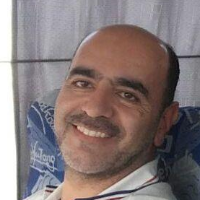Study of graphoglyptid trace fossils of Paleocene-Eocene flysch deposits from North of Birjand, East Iran
Author(s):
Article Type:
Research/Original Article (دارای رتبه معتبر)
Abstract:
Introduction
In this research, in order to study ichnology of Paleocene-Eocene flysch deposits of the north Birjand, one section has been measure and smaples collected. The studied section is located about 40 km north of Birjand and 5 km east of Friznook village. Geographical coordinates are 32° 12′ and 33° 48′ north latitudes, and 58° 51′ and 59° 20′ east longitudes.
Material & Methods
Methods of research include sample collection, sample preparation and identification of ichnogenera and ichnospecies. At first, the based and top of the section identified, and then the section measured bed by bed. Forty-four specimens of ichnofossils have been identified and studied in field. Then, seventy specimens have been collected and studied in laboratory.
Discussion
In Birjand and Qayen areas, Paleocene and Eocene deposits are composed of different facies including flysch and carbonate as well as volcanic rocks and their distributions are related to structural zone of the area. The studied section (3662 m) includes alternations of siliciclastic sediments that formed during collision along with thin-bedded carbonate intercalations. There are foraminifera and other bioclasts such as algae and bryozoans in carbonates beds. The bioclasts are broken and formed fragments and seems to be re-deposited in the basin and formed allochthnous limestone. Based on fossil assemblages and stratigraphical position of sequence, two flysch units are separated and belong to Paleocene and Eocene age. In the studied sectione, twenty two ichnogenera and twenty six representative ichnospecies have been identifies as follow: Acanthorhaphe, Belcosmorhaphe, Cosmorhaphe, Fustiglyphus, Gordia, Granularia, Halopoa, Helminthoida, Helminthopsis, Helminthorhaphe, Laevicyclus, Megagrapton, Ophiomorpha, Palaeophycus, Paleodictyon, Phycodes, Planolites, Scolicia, Spirophycus, Spirorhaphe, Squamodictyon and Thalassinoides. Simce ichnogenera are formed in place, therefore they are clearly indicative of environmental conditions. Therefore they are important in interpretation of environmental conditions of sedimentary basins (Frey, 1978; Ekdal et al., 1984; Bromley, 1996).These biogenic structures are applicable for determination of depth, type of sediments and size of grains, oxygen contents and organic material (Bromley, 1996). Summary of lithological facies of the studied sequence as follows:
1- Carbonate facies with marly beds that probably deposited in a carbonate ramp.2- Conglomerate facies that belong to submarine fan channels
3- Thick bedded sandstone facies with shale and marl intercalations that belong to middle part of the submarine fan.
4- Marl or shale facies with sandstone- thin-bedded siltstone intercalations that belong to distal part of submarine fan.
5- Marl or shale facies with thin-bedded siltstone interbedded that belong to deep environment of the basin.
Trace fossils, based on, sedimentation could be divided into two groups. 1- Trace fossils that form on muddy substrates before event sedimentation. These trace fossils are good characters for quite environments and often are created where the turbidity currents did not effect on the basin floor.2- Trace fossils that are formed after event sedimentation. The previous group are replaced by these trace fossils in unrest condition and intense erosion. The assemblage that are formed before sedimentation including Acanthorhaphe, Cosmorhaphe, Helminthoida, Helminthopsis, Helminthorhaphe, Laevicyclus, Megagrapton, Paleodictyon, Spirorhaphe, Spirophycus, Squamodictyon (Frey and Seilacher, 1980; Pemberton and Frey, 1992; Uchman and Wetzel, 2011; Uchman, 2007). According to ichnofacies classification (Pemberton and Frey, 1992) that include of sedimentary environment from terrestrial to deep marine environment, the studied and identified trace fossils belong to Nereites ichnofacies. The Nereites is divided into three subichnofacies including Ophiomorpha rudis, Paleodictyon and Nereites (Uchman and Wetzel 2011). Subichnofacies Ophiomorpha rudisare formed with thick-bedded sandstones that are deposited in channels and upper fan. Subichnofacies Paleodictyon could be assigned to sandy deposits of normal flysch and subichnofacies Nereites could interpret as outer parts of submarine fans with muddy sediments. Generally, Nereites ichnofacies contains fine grains sediments and typical pelgic sequence. According to above, graphoglyptid forms meander shape and before sedimentation assemblages, the studied assemblage could be assigned to Nereites ichnofacies and deep marine environment (Buatios et al., 2001; Leszczyński, 1992, 1993; Wetzel and Uchman, 1997; Uchman, 1995; Seilacher, 2007; Ekdale, 1985; Pickerill and Mitchell, 1999; Leszczyński and Seilacher, 1991).
Conclusion
Ichnological and sedimentological analysis of the studied section indicate quite condition substrate for the basin. It is suggested environmental conditions such as amount of oxygen in substrate, organic material in the sediments, abundance of turbidity currents, texture of sediments, rate of sedimentation, abundance of fauna assemblage and style of their distribution led to abundance and variety of ichnogenera.Language:
Persian
Published:
نشریه دیرینه شناسی, Volume:3 Issue: 1, 2015
Pages:
73 to 92
magiran.com/p2010470
دانلود و مطالعه متن این مقاله با یکی از روشهای زیر امکان پذیر است:
اشتراک شخصی
با عضویت و پرداخت آنلاین حق اشتراک یکساله به مبلغ 1,390,000ريال میتوانید 70 عنوان مطلب دانلود کنید!
اشتراک سازمانی
به کتابخانه دانشگاه یا محل کار خود پیشنهاد کنید تا اشتراک سازمانی این پایگاه را برای دسترسی نامحدود همه کاربران به متن مطالب تهیه نمایند!
توجه!
- حق عضویت دریافتی صرف حمایت از نشریات عضو و نگهداری، تکمیل و توسعه مگیران میشود.
- پرداخت حق اشتراک و دانلود مقالات اجازه بازنشر آن در سایر رسانههای چاپی و دیجیتال را به کاربر نمیدهد.
In order to view content subscription is required
Personal subscription
Subscribe magiran.com for 70 € euros via PayPal and download 70 articles during a year.
Organization subscription
Please contact us to subscribe your university or library for unlimited access!


